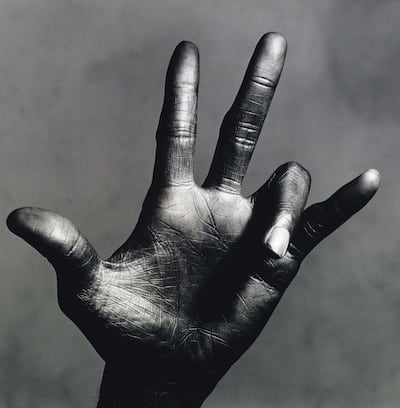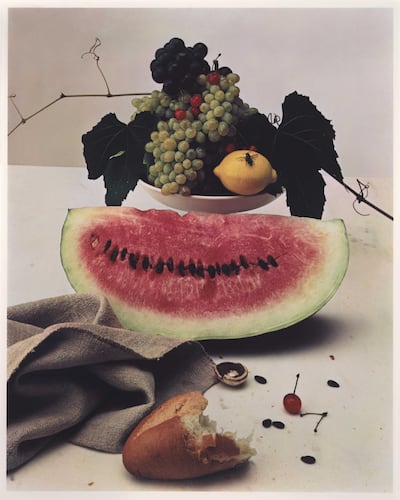"I myself have always stood in awe of the camera," American photographer Irving Penn once said. "I recognise it for the instrument it is – part Stradivarius, part scalpel."
Untroubled, the first exhibition of Penn’s work in the Arab world, underlines the truth of this statement. Penn’s photographs are deeply moving and deceptively simple, at once beautiful and tightly controlled, almost surgical.
The show, curated by Matthieu Humery, marks the launch of the Mina Image Centre, a new non-profit space in Beirut. It includes 49 of Penn's original photographs from nine series shot over four decades. Among them are some of his most striking pictures, including his close-up of Pablo Picasso, the lower half of his face hidden in the collar of his coat, peering out from under the brim of his hat.

Born in 1917, Penn was most famous for his fashion photography. He took hundreds of photographs for Vogue, including more than 100 covers, but as Untroubled demonstrates, his work extended far beyond the worlds of fashion and celebrity.
Including still lives, ethnographic studies, skulls, portraits of manual labourers and close-ups of discarded cigarette butts, the exhibition highlights Penn’s true genius – the reverence with which he approached his subjects, whether a famous actress or a dying flower.
The show includes two of his powerful photographs of Miles Davis's hands, eloquent portraits that reveal more than a headshot in their stark simplicity and celebratory beauty. A series from the early 1950s, Small Trades, consists of dignified, formal portraits of blue-collar labourers in their work uniforms. A sewage cleaner in New York and a fishmonger in London are photographed with as much care and gravitas as the Hollywood darlings of the day.
Among the more famous works on show are six images from Penn's Corner Portraits series, which he began shooting in his studio in 1947. Placing his famous subjects in an acute angle, penned in by bare walls, Penn strips away the flash and glamour of celebrity, focusing in detail on an awkward pose, a wrinkled sleeve, an unguarded expression.
Alfred Hitchcock sits with his fingers interlinked, his back slumped, the faint wrinkles on his forehead and pouches under his eyes conveying a tired dignity. Salvador Dali sits with legs and arms akimbo, an inverted echo of his famous moustache, as though trying to fill the frame. His wife of 42 years, Lisa Fonssagrives-Penn, who was widely considered to be the world's first supermodel, stares straight down the camera lens as she reclines in a chair while holding a cigarette.The striking photo is simply titled Harlequin Dress.
Manal Khader, director of Mina Image Centre, says she chose to launch the new space with Penn's work because he left an indelible mark on the medium. "I wanted to start with an artist who brings into debate the history of photography," she says. "It's true that photography is new to the region, but it has a very long history, and for me, Penn is one of those people who changed the perception of photography and brought it into the art realm."
The new centre is housed in a striking building near the port and includes two basement spaces, housing dark rooms, studios, storage, offices and a large ground-floor exhibition space with soaring ceilings, divided naturally in two by the lobby, which will house a cafe. The space belongs to a Lebanese family who wish to remain anonymous, and is presided over by a board that includes Khadar and Lebanese photographer Fouad Elkoury, who masterminded the project.

"It's an exhibition space that also holds a lot of parallel events, such as discussions, debates, and conferences. But it can also be used to produce, because [photography lab] Studio Palladium will be moving into our building, so we will co-operate and work together on the production of the image," says Khader. "That means you can come and exhibit here and do all your production of the exhibition in-house. The idea is to make it not just a static space for exhibitions, but a dynamic place, to have as many people as possible come in every day, not necessarily just to see a show, but to work, have a coffee, print and experiment."
The Mina Image Centre will hold three to four major exhibitions a year in the main gallery space, while the smaller raised area near the entrance will be programmed independently, hosting up to 10 events a year, including book launches and exhibitions by emerging artists. While the centre will primarily focus on photography, Khader says their definition of "image" is broad and may include paintings, sculptures, installations and video. "We want to promote and work with the image in its larger context, with its complexity and its layers," she explains. "We look for good ideas, and good works, regardless of where they come from, but of course we would like to do things that are relevant for our region."
Khader has fought hard to bring Penn's photographs – which are on loan from the Pinault Collection in Venice – to Beirut. "For me, he is the photographer. When I saw him in 2017 in the Grand Palais in Paris, I almost cried," she says. "I'm so touched by his work. I think he's such a perfectionist, he has such a strong vision in composing and in controlling his object, be it a person or a thing."
At the centre of the exhibition, Humery has hung nine photographs from Cranium Architecture, a series Penn shot in Prague in 1985, capturing animal skulls in all their macabre, polished beauty. Beside them hangs one of Khader's favourite prints, The Poor Lovers. The photograph captures two human skulls, one balanced atop the other, both missing teeth. Poignant and timeless, it is a distillation of Penn's raw emotive power.
Untroubled is at the Mina Image Centre in Beirut until April 28


